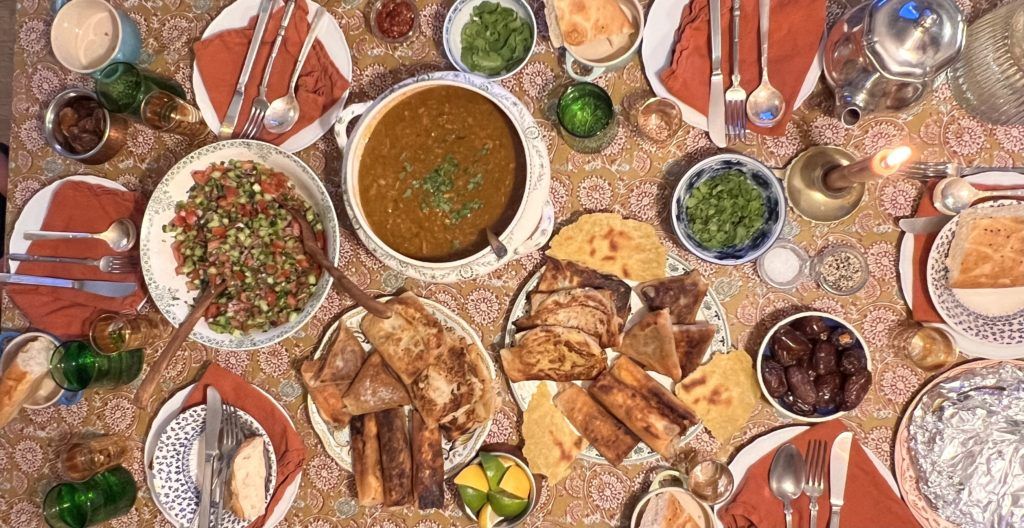Deepening a new friendship during an afternoon spent preparing familial recipes of Ramadan, sharing the resulting feast, and chatting all the while.
story
Algerian Iftar
I met Soraya when she attended a workshop I hosted with a mutual friend. She was (and still is!) full of energy, sweet, and a fellow multi-hyphenate, creative soul. I could see us becoming friends, but I also thought she was probably too busy for new pals in her life! When upon her goodbye she suggested we meet up, I chalked it up to pleasantries, though hoped I would see her again.
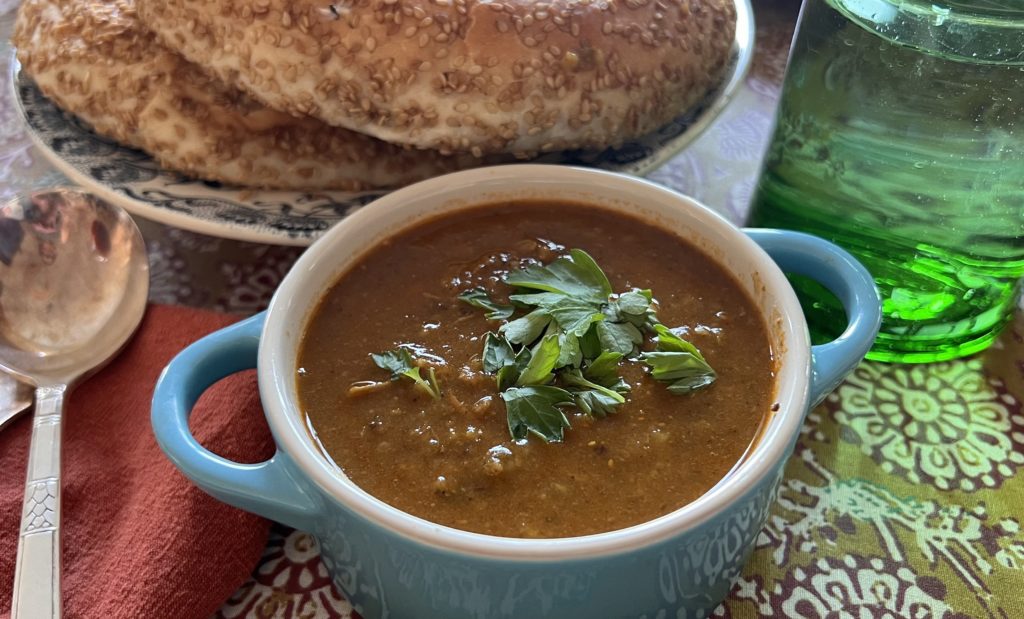
Some weeks later, we bumped into each other at an event for another mutual friend. We got talking and she once again suggested we go to a hammam together. At the workshop, she had already explained why hammams are an important part of her self care, a cleansing of soul and body, as well as a reconnection to her roots, all in one afternoon. “The woman who scrub you sing in Arabic,” she reminisced, “just like my aunties back in Algeria!”
It sounded lovely, and given that my only other bathhouse experience was in Budapest, with a Hungarian friend as my guide, I was excited for my first hammam experience to also be led by an expert friend.
About a few weeks later she and I were lathering black soap on our bikini-ed bodies. I was grateful to follow her instructions on the proper steps to take to clean before heading to be scrubbed down by the ladies. In the sauna, between the three, head-to-toe black soap latherings, we enjoyed a few solidary moments, laying on the benches to take advantage of a less-crowded day to really sink into this ritual of cleansing and renewal.
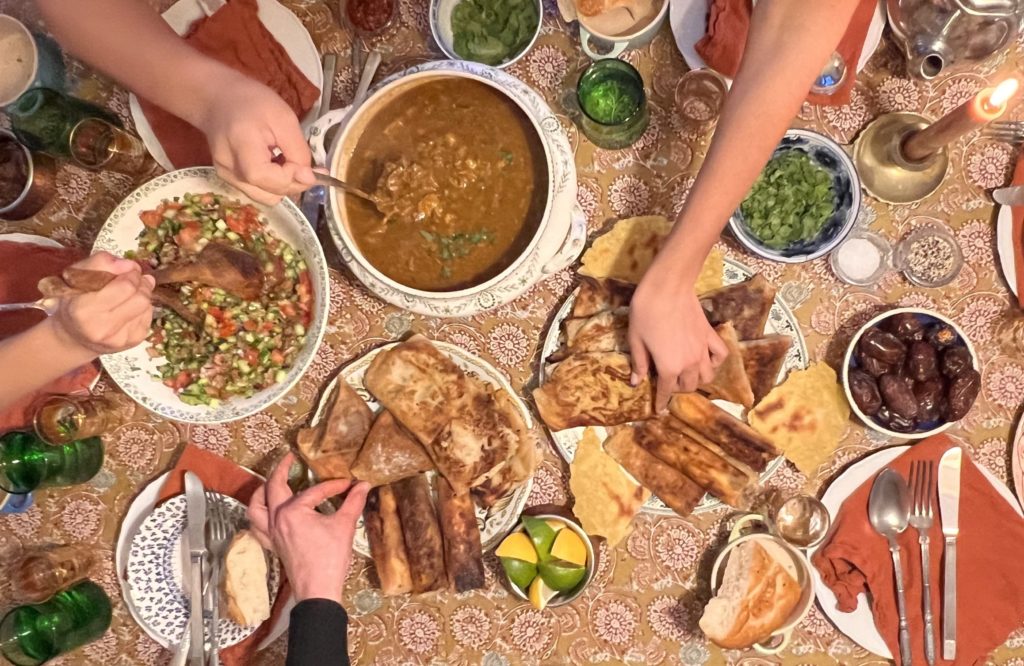
But once that process was done, there was time for a bit of chatting. We climbed atop the large heated stone platform to continue our relaxation, and in a curious mix of French and English, we spoke of the things that we wished to wash away: people or situations we no longer wanted to give our precious energies to, and the things we wanted to make more space for in our lives.
It came up that Ramadan was approaching, and I asked about her family traditions. I mentioned that each year we make Maamouls for ourselves and friends observing Ramadan, and how enjoy learning about the varied Ramadan traditions of our friends. She suggested we do an Algerian iftar and I couldn’t have been happier to oblige her, after all, this Cultures Capsules project was one of the things I was trying to make more space for in my life.
Fast forward a few weeks, and we were using every available inch of space in my tiny Paris kitchen to whip up a fantastic feast, with the help of my daughter. Meanwhile our sons bonded over soccer and playing a bit of basketball and darts.
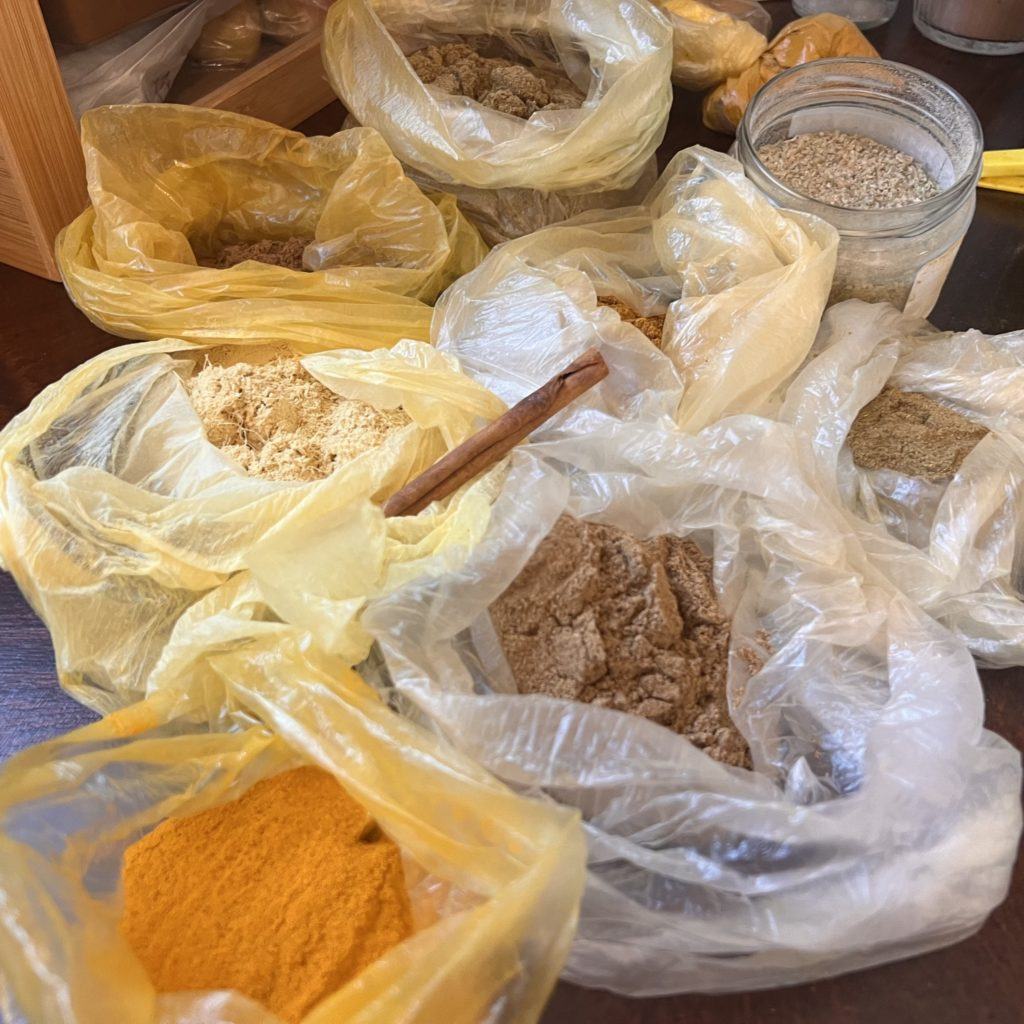
We were even able to use spices that came directly from Algeria because Soraya’s dad brings them back for her. When she opened all the easy-to-travel-across-Paris bags, it smelled so heavenly. We could have been walking through a spice market.
Here we share all the details for how you can replicate this delicious homemade Algerian iftar at your own table. It does take some time, but. it is so very well worth it.
recipe
The Game Plan
There is a lot to do! The chorba needs a while on the stove, and the bricks take several intermediary steps before you are ready to assemble them, and then fry them right before serving. Here’s an overall game plan to keep you on a good path.
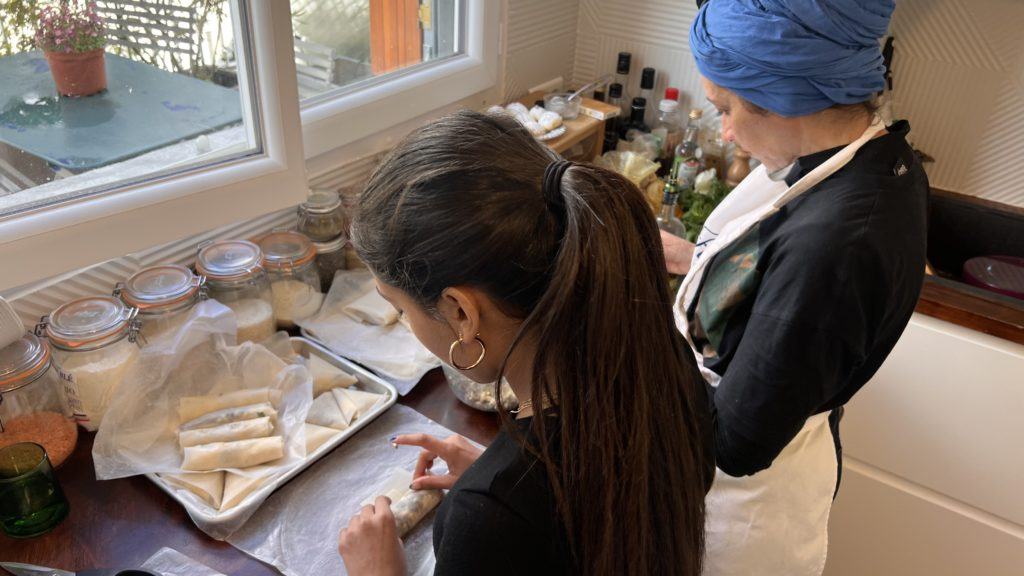
- Double-check that you have all of your ingredients. There are quite a few and you don’t want to be in the middle of cooking and find out something crucial is missing (ahem! i.e. don’t be like Megs you forgot the green olives!).
- Boil the potatoes until cooked, and set aside when ready.
- Brown the lamb, and do the first few steps of the chorba.
- Once the lamb is cooking under pressure, begin making the various parts of the brick fillings. Start by scrambling the eggs, and sautéeing the beef per the recipe, and once the potato is cool, mash it with the tuna.
- Meanwhile, when the lamb is done cooking under pressure, begin the next few steps so that it can continue to stew and deepen in flavor.
- If you are making bread, now’s the time to make the dough.
- Make the salad and keep cold until ready to eat.
- Shape the various bricks per the recipes, and keep covered by the paper they came in, in order to keep them moist and not brittle. You’ll want to cook them just before meal time so they are crispy and warm.
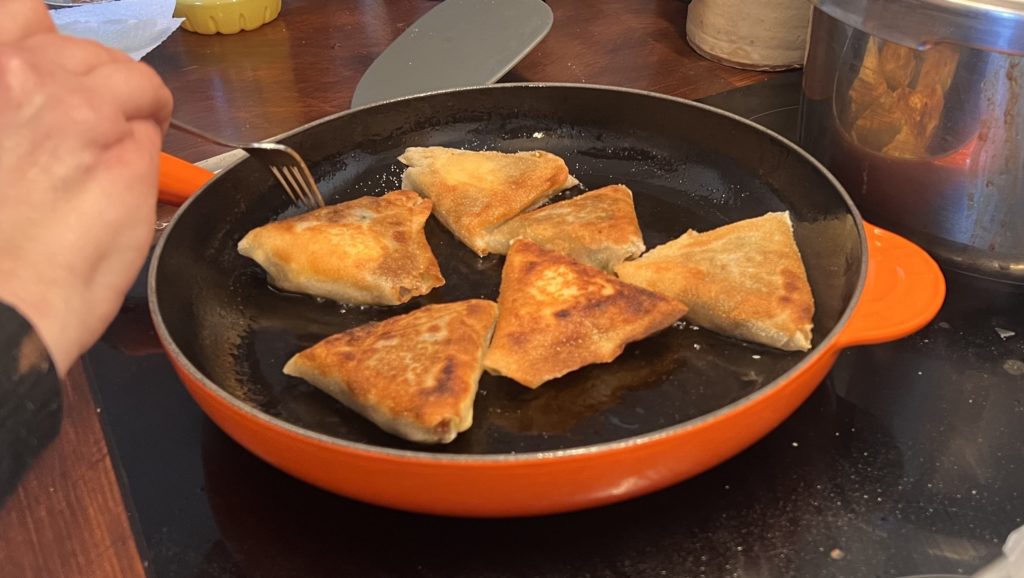
music
Rai + Dance Music + Quran
While Soraya appreciates listening to the Quran for its calming, meditative qualities, she also enjoys dancing and singing along while she is cooking! So there was plenty of that, too.
The week prior, when I asked Soraya what I should include in a playlist, she told me I had to include Le Rai (Algerian folk music), which is very typical Oranais (i.e. of Oran the city of cabarets and festival, and the birthplace of Rai). She also provided the names of some of her favorite Algerian artists (Ibir, Cheb Khaled, Cheb Hasni, Cheba Zahouania and Rachis Taha), which I used to draft the first version of the playlist, and then she cleaned it all up to match her memories and preferences.
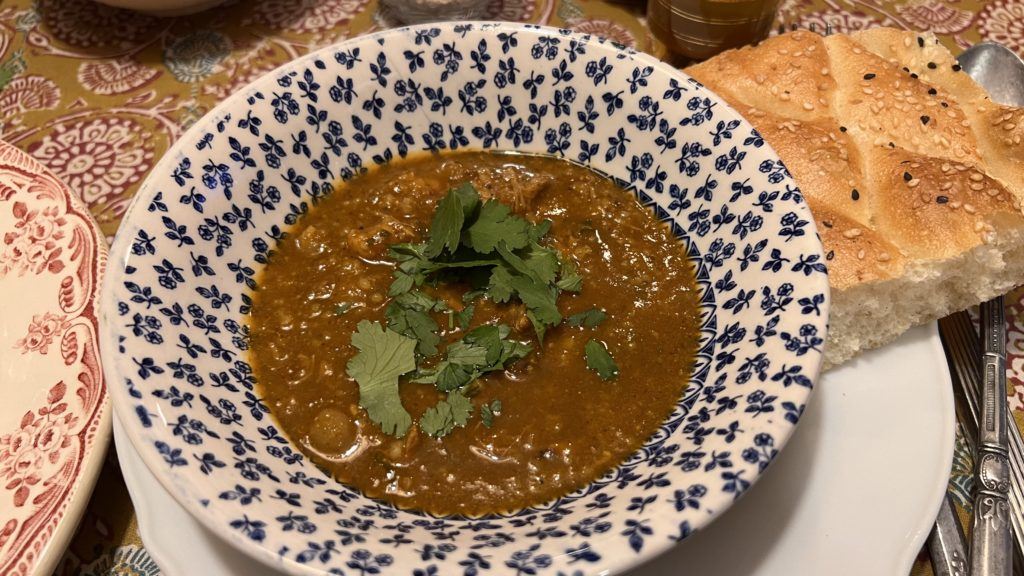
Why is everyone called Cheb? Well, it’s sort of the equivalent of like MC or DJ featured in some hip hop names. It’s a bit of an honorific, but in the case of Cheb, .. give the etymology given its origins in French verlan slang?
If you haven’t already, hit shuffle play and get it on your speakers!
recipe
Chorba
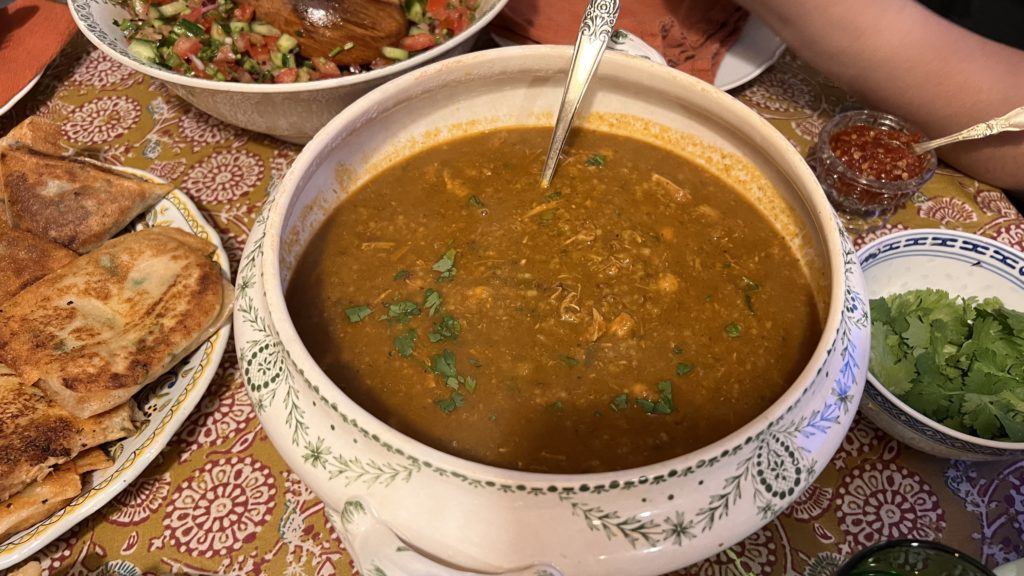
What a warm hug this was. So rich and flavorful, instant sustance for mind, body and heart. It was so wholesome that it felt as if it was transporting me into memories, but I had never had it. In terms of taste, the closest match I could pull from memory was a Tunisian stew that I used to make, but that wasn’t it. The taste was richer both literally and figuratively; it was more than just the recollection of having eaten it, it was as if each bite had a story to tell.
So I of course had to ask Soraya what memories it brought up for her. Did she recall the first time she ate it, and whose table she was at? Whose kitchen was she in the first time she saw it being made, or the first time she helped?
Soraya’s Chorba
Ingredients
- 600 g leg of lamb cut into 2 inch chunks
- olive oil
- 2 long, skinny green pepper, whole
- 1 box of flat parsley
- 1 box of coriander
- 1 box of fresh mint
- 1 branch of celery
- 1 can crushed tomatoes
- 1 can chickpeas
- 1 tbsp tomato paste un peu
- 1 packet chorba spices
- 1 stick stick of cinnamon
- 2 large onions, diced
- 1 lemon or lime
Serving
- harissa a bit
- 1-2 loaf round semolina bread
Instructions
Brown and Pre-cook the Lamb
- Heat a large, hot heavy bottomed pot to medium-high heat. Add some olive oil and brown the lamb, turning only once it gets a nice bit of malliard action going on. Towards the end, toss in the peppers, whole.
- When the pieces of lamb are browned all over, add the branch of celery cut into 2, the diced onion, all of the spices, and cover with water. Add the parsley, coriander and mint, and stir in. Cook at high pressure for — minutes, and then quick release it.
Prepare the Chorba to Stew
- When the lamb has cooked, remove thewhole peppers and celery from the pot of liquid and keep them aside. Remove the meat and put it into a bowl. Shred the meet into small pieces and keep aside. Discard the bones.
- To the pot of liquid, add the crushed tomatoes and tomato paste, and more water. Use an immersion blender to make all of this into a smooth soup.
- Add the shredded lamb into the smooth soup, stir to combine, cover, and cook over low heat for at least an hour.
Enjoy
- Enjoy alongside the same feast we propose here, or simply with some round Algerian semolina bread.
- Serve with coarsely chopped leaves of parsley and coriander, and Algerian harissa for anyone who wants a little kick.
Notes
- ? harissa in the stew or only for along side serving?
- chorba spices… what do i need to know/add here?
- parsley, corriander and mint… just the whole branches? and how much? because i think i got one bunch of each but we used for all the dishes, including garnish.
- need more guidance on the amount of water before and after pressure cooking
- how long to cook the chorba the 2nd session?
recipe
Algerian Bricks, Three Ways
These Algerian bricks had a lot more pre-cooking preparation required than the Tunisian bricks we made and enjoyed with Asma, but they were well-worth the effort!
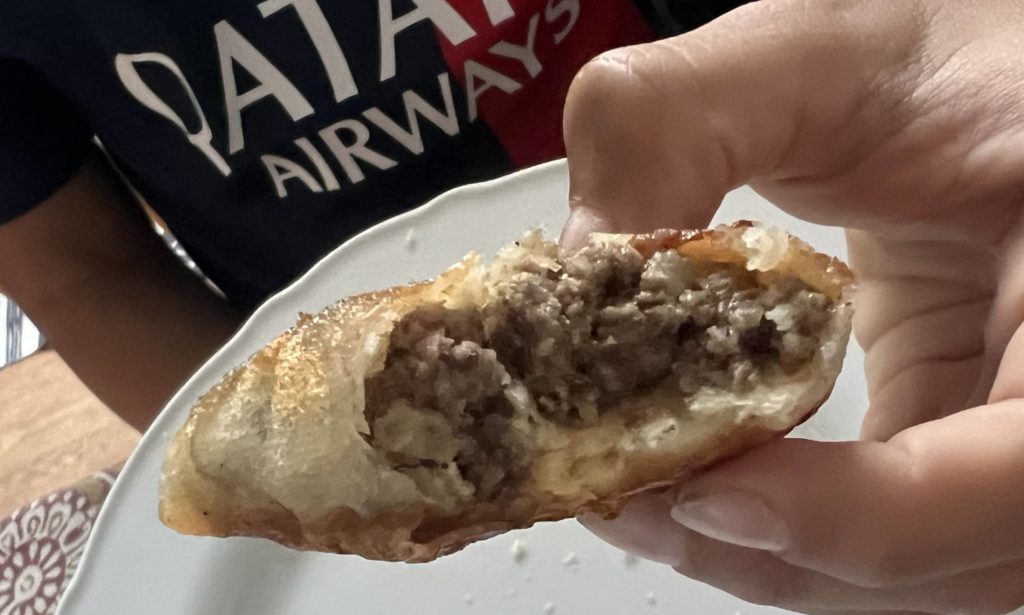
Each with their unique and delicious combinations, it was hard to pick a favorite, though that particular night the cigars disappeared first, followed by the beef, egg and cheese.
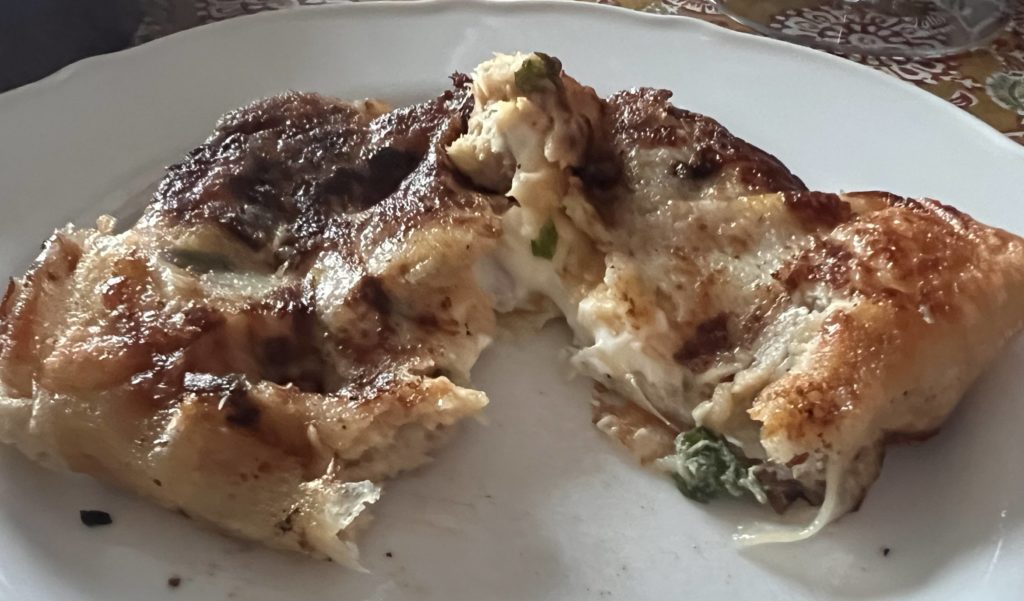
Someday I will dive more into the story of bricks and their various fillings. How are they related to the potato stuffings we see in classic Indian samosas, and how is the leaf of brick related (or not) to filo dough or other pastry dough of that region. The filling Asma put in her Tunisian Brick were more pantry-based, where as Sorya’s took preparation. But was the back story more of using up leftovers of other dishes? If anyone has answers, write to us!
Soraya’s Bricks Three Ways
Equipment
- large frying pan
Ingredients
- 2 large potatoes
- 1 cup red onion, diced 1 med-lg size
- 1 tsp oilve oil
- 6 eggs
- 500 g ground beef
- ??? spices for beef
- 500 g natural tuna
- chopped parsley leaves
- chopped cilantro leaves
- ??? spices for potato-tuna
- 2 packages of bricks 2×10 bricks
- 1 jar green olives, pitted
- 1 packet La Vache qui Rit find equivalent for USA
- sunflower oil for frying
- salt and pepper to taste
Instructions
Prepare the Potatoes and Tuna
- Boil the potatoes in a medium pan of salted water. Meanwhile, chop the onion and herb leaves, and prepare the rest of the ingredients for all of the bricks.
- When fully cooked, remove and discard the skins, putting them in large bowl. Mash roughly with a fork, and allow to cool. Move onto the eggs and beef, and return to the next step later.
- When the potatoes are cool, empty the can of tuna into the same bowl. Add 1/4c of the red onion, parsley, coriander, some salt, …. SPICES? BLACK PEPPER? and stir to combine. keep aside.
Prepare the Scrambled Egg + Ground Beef
- Meanwhile, crack the eggs and whisk them with a bit of salt and pepper.
- Heat a large skillet to medium heat, and when hot, add olive oil. Add the eggs, and allow to set, then gently stir occasionally until the eggs are just cooked. Reserve the eggs in a medium bowl and allow to cool.
- Using the same skillet, heat to medium -high heat, and when hot, add olive oil. When warmed, add the beef, letting it brown a bit, but also stirring. After a few minutes, add 3/4c of the diced red onion. Add salt, black pepper and SPICES? When cooked, remove to a medium bowl and allow to cool.
Assemble the Bricks
- Clear a workspace big enough to lay the bricks flat in front of you, with all of the stuffings close at hand. We made these three types in three different shapes as a way to tell them apart from each other.
- BEEF + EGG + CHEESE (triangles)– Start with the brick folded in half, the rounded part towards you. On the far right side, leaving about 1 inch/2.5 cm from the edge, add about a third of cup of the cooked beef, add about 1 heaping tbps of scrambled egg, and 1 triangle of Vache Qui Rit. – Fold up the round part of brick towards the top/flat part, tuck the far right edge on top, starting to make a triangle. Complete the triangle by tucking and flipping the filling towards the rest of the empty brick, and continuing to do so until the full brick has been used, tucking in the last part to keep it together. Keep aside, covered in the paper the brick came in so as not to dry out.
- TUNA + EGG + CHEESE (squares)– Start with the whole round brick. Using about a third cup of the tuna mixture, shape a square-ish hollow shape in which to put the egg and cheese. The "walls" should be an even height of about a half inch. – Make a square shape by folding up the brick across the square you have made, alternating sides and folding/tucking as needed to keep the contents inside. Use your finger to add a bit of water on the last flap brick to keep it sealed.
- BEEF + EGG (cigars) – Mix the remainder of the beef and egg together. – Start with the brick folded in half, the rounded part towards you. put the beef and egg mixture in a log shape, about 3cm/1"+ thick, and 5"/12cm long. Take the bottom part of the brick and fold it over the log of filling tucking it snuggly. One at a time fold the right and left parts of the brick toward one another, making right angles of the brick in relation to the log, and again making it fit snugly. Now roll the wrapped, full part away from you to finish the cigar shape. use a bit of water on the last edge of the brick to help it stick.
Cook the Bricks
- Heat an oven to 100C/210F, with a large baking sheet inside it. Too keep them warm before serving, add cooked bricks in a single layer (lest they get soggy!) as they come out of the pan.
- Just before mealtime, heat a large fry pan over medium heat. When it is hot, add the oil.
Serve
- Enjoy soon after frying. Can be enjoyed with a bit of Algerian harissa.
Notes


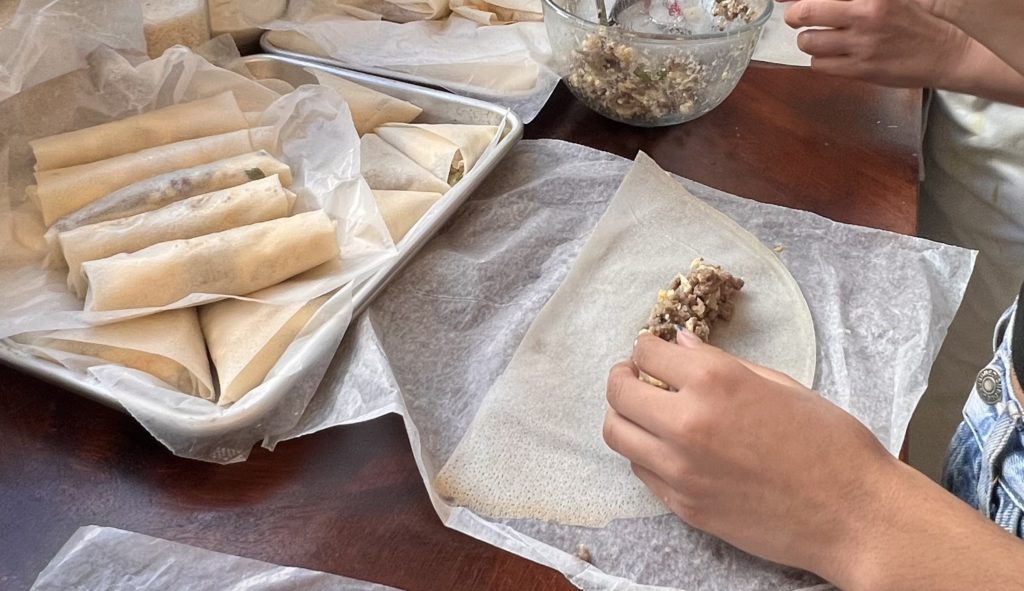
recipe
Algerian Slata
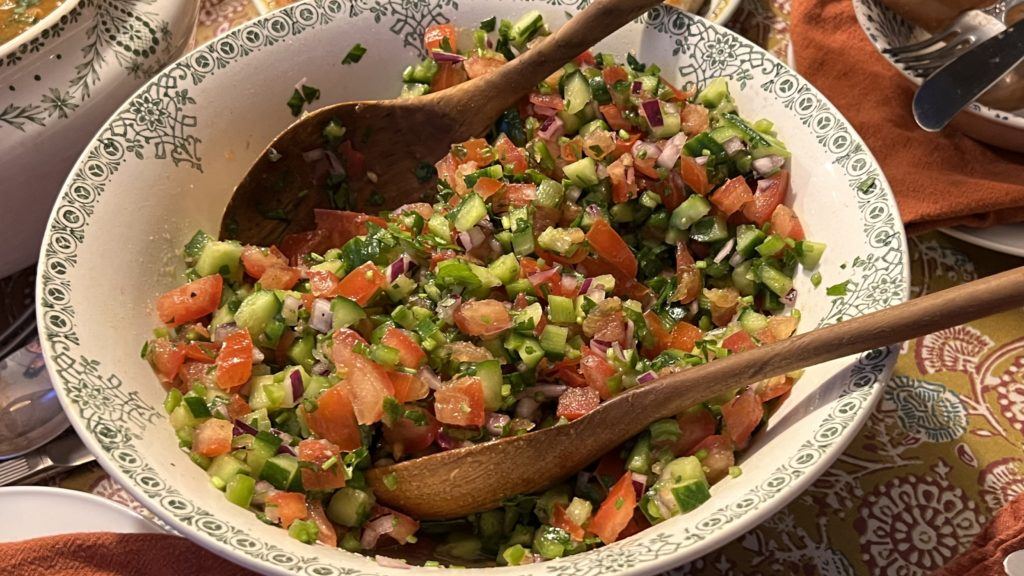
A light fresh accompaniment to the heavier bricks, and soul-warming chorba.
Algerian Slata Salad)
Ingredients
- 3 Persian cucumbers
- 3 tomatoes
- 2 green, long skinny peppers
- 1 red onion
- olive oil
- vinegar
- salt and pepper
- 1 lemon (the fresh juice of)
Instructions
- Get a bowl large enough to hold all of the chopped veggies, plus room to toss them.
- Cut cucumbers into a small, 1cm dice, removing about half the skin, and most of the seeds (so as not to make the salad too watery). the red onions in the smallest, adding them to the bowl as ready. You do not want to keep the seeds of the
- Cut the tomatoes into a small, 1cm dice, again removing most of the seeds (so as not to make the salad too watery).
- For the green peppers, remove the seeds, and cut into a small, 1cm dice.
- Lastly, skin and cut the red onions to a very small dice, adding them to the bowl with the other veggies.
- Add the olive oil, vinegar, lemon juice ,salt and pepper and toss to combine. Taste and adjust as needed.
- Keep cold while cooking the bricks. It is best eaten fresh, but kept in the fridge and given a nice stir, you can also enjoy it the next day.
recipe
Semolina Ma’amouls Two Ways
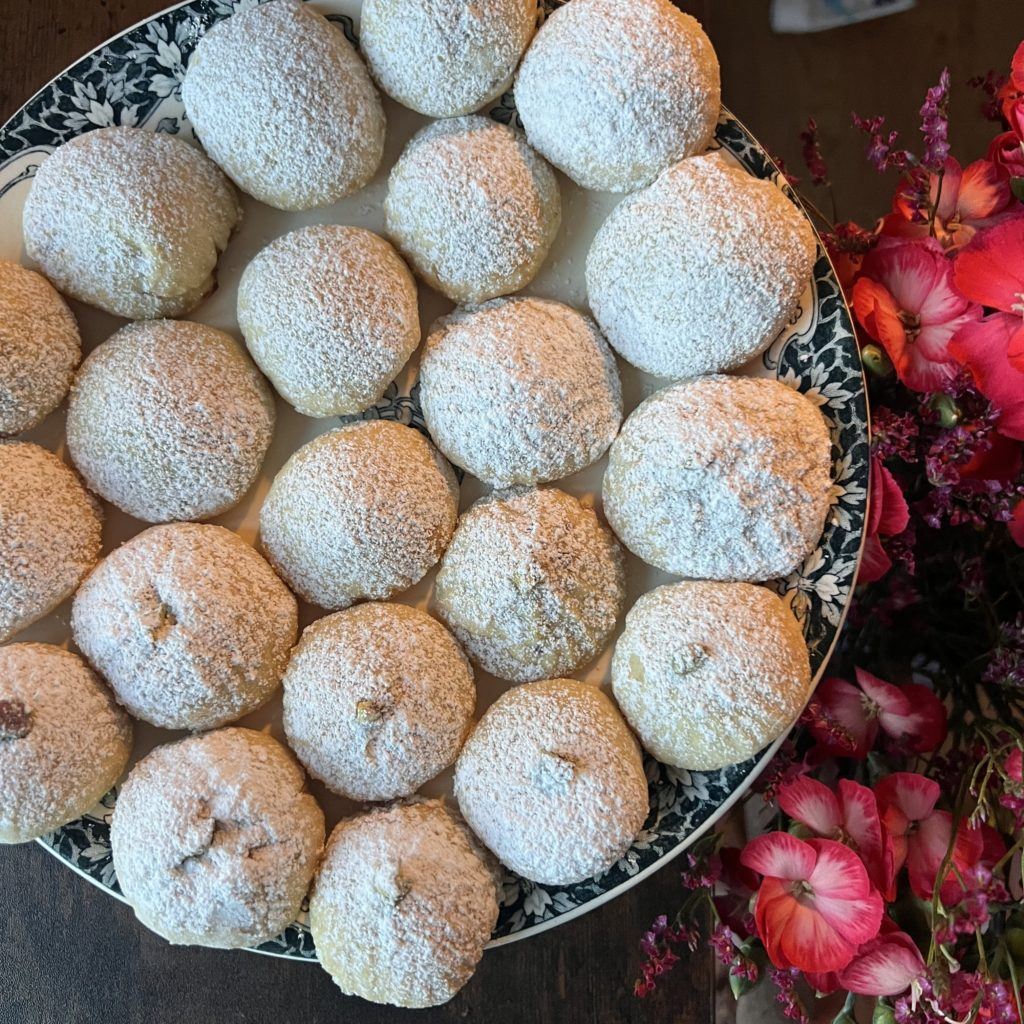
And it would not be Ramadan if the kids and I did not make and share our Ma’amouls! This year we made our original spiced date version as well as the Tunisian-inspired pistachio and orange blossom filling we learned from Asma Ramadan 2020, shortly after she made her Tunisian feast for us.
Deeeeelicious, and not too much work when you have 2 extra pairs of hands to do the stuffing.
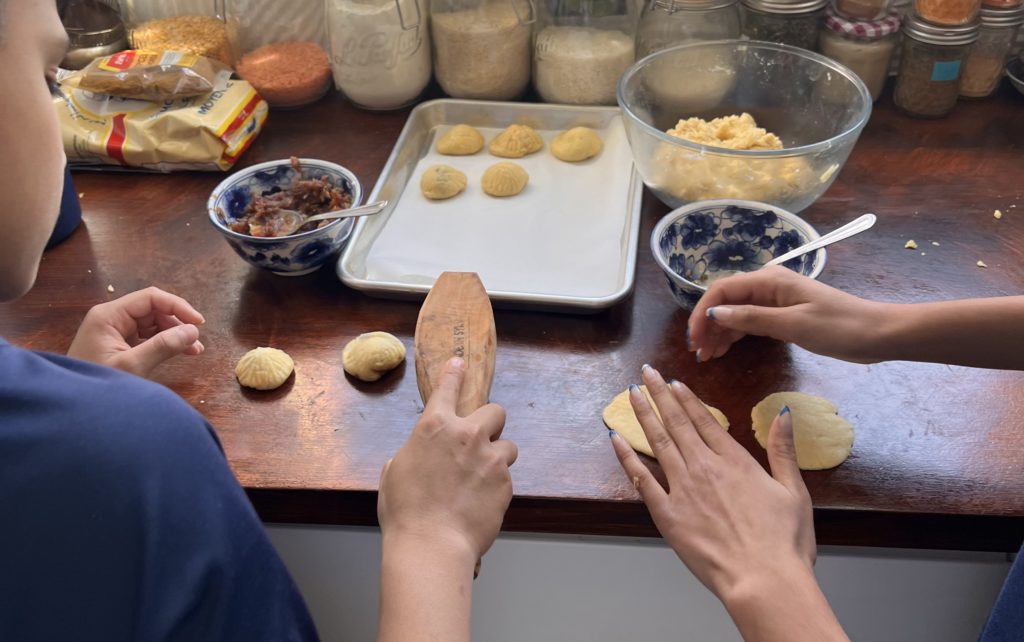
NEED TO UPDATE THIS RECIPE
Meghna’s Semolina Ma’amouls
Ingredients
Dough
- 1 cup warm milk
- 1/2 tsp active dry yeast rounded
- 1 cup unbleached all-purpose flour
- 3 cups fine semolina
- 3 tbsp sugar
- 3 tbsp sunflower oil
- 6 tbsp unsalted butter melted
- 1 tsp pure vanilla extract
- ¼ cup water if needed for dough to reach correct consistency
Filling
- ¼ cup roasted, unsalted pistachios no shell, finely chopped
- 2 ½ tbsp sugar
- 1 tsp orange extract
- ¼ tsp cardamom powder
- 2 tsp water or more as needed to get desired consistency
For Garnish
- 1/4 cup powdered sugar
Instructions
Prepare the Dough
- In a small bowl, mix the warm (not hot!!) milk and yeast. Set aside until the yeast has softened and is foamy, about 8-10 minutes.
- In a medium bowl, mix flour, semolina, and sugar.
- Rub the oil and melted butter into the flour with your fingertips until the mixture is an even, sandy texture.
- Add the yeast and milk mixture and vanilla. Mix gently with your fingers.
- Add water, a little at a time, mixing gently after each addition, until the dough comes together in a soft and shaggy dough.
- Cover the dough and set aside to rest for 10 minutes while you prepare the filling.
Prepare the Filling
- Finely chop the pistachios.
- Mix the chopped pistachios with the rest of the filling ingredients in a bowl and let sit until ready to fill.
Shape the Cookies
- Preheat your oven to 350°F (177°C) and prepare a baking sheet with parchment paper.
- Take 1 tbsp of dough, roll it into a ball, flatten it into a disc of about 1/8-1/4 inch thick.
- Place 1 tsp of filling on the center. Wrap up the edges of the dough around the filling and pinch it together.
- Roll it between your hands again to make a ball shape.
Bake
- Place the cookies on the parchment-lined sheet 1 inch apart.
- Bake for about 10-12 minutes, turning halfway through. Cook only until just barely beginning to brown on the top.
Enjoy and Share with Friends!
- Allow to cool completely then dust with powdered sugar using a sieve.
Notes
Bonus
Algerian Home Cooking on On Va Dégouster
As luck would have it, in the days leading up to our Algerian iftar, one of my favorite podcasts was featuring Algerian home cooking! The On Va Déguster episode with Hanane and Anissa Abdelli is was a wonderful appetizer to our Iftar with Soraya and Issa.

I have been eyeing her cookbook Goûts d’Algerie, and again tempted to buy it, a stack them staring at me from the neighboring counter while I was enjoying their super-flavorful Chakhchoukha at their restaurant Mama Nissa.
The episode features a recipe for an Algerian bread which didn’t seem too hard, but I must have done something wrong as it came out quite hard (though tasty, and still lovely to soak up the chorba!).
